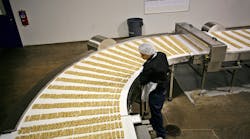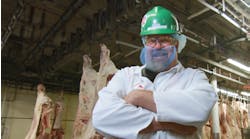This deeper dive into our 2019 Processor of the Year is part of a three part series. You can read about Hearthside's business here as well as about its R&D in this article.
The people who run the plants of Hearthside Food Solutions have a lot to boast about. But they have to keep it to themselves.
"It would be hard to find a cookie or cracker aisle in any leading grocer that does not contain multiple products from Hearthside production facilities,” says Richard Roscoe, manager of one of the four Hearthside plants in or near Grand Rapids, Mich. “Hard as you may look, however, you will never see our name. It is one of the many ways we protect our customers and their brands.”
As a co-manufacturer, discretion is important; versatility more so. Hearthside’s mission is to make and package the SKUs that brand owners, large and small, do not produce for themselves for a host of reasons that may include capacity, capabilities and efficiency.
“We can often enable companies to bring products to market more quickly than if they relied on internal capabilities alone,” Roscoe says. “Our aim is to be faster and more flexible. This often includes rapid changeovers and multiple commercializations.”
Whether it’s partial or full volume of an established SKU, commercializing and producing a new SKU or putting an existing product into a different package (or several of them), Hearthside plants handle tasks that often differ by the day, and sometimes by the shift.
Hearthside CEO Chuck Metzger (left) speaks with Richard Roscoe, manager of one of the four Hearthside plants in the Grand Rapids, Mich., area.
Chuck Metzger, who was recently promoted to CEO after two years as chief operating officer, estimates that Hearthside handles 700 to 800 SKU commercializations each year. Many of them involve packaging variations, which are especially important for the energy bars and other snacks that Hearthside produces. Brand owners want their snacks in a lot of different retail outlets, which means a lot of different packages.
“It requires all this complexity – smaller-pack architecture, price-point architecture – which is the reason in a lot of cases why we exist,” Metzger says.
Hearthside has to handle versatility across plants as well as within them. With 39 plants globally, that’s a major challenge, especially with the acquisitions the company has made in this decade.
Standardizing change
Hearthside achieves versatility, paradoxically enough, through standardization. The company’s operational principles are formalized in the Hearthside Performance System (HPS).
When Hearthside acquires a food plant, its management gets a visit from company personnel trained to teach HPS. The new plant’s management then visits one or more established Hearthside plants to see HPS in action.
HPS spells out the way Hearthside expects things to be done and then measures and tracks the results plant- and company-wide. “We have a whole set of KPIs – True North metrics, if you will – that starts at the top of the company in terms of setting our objectives and cascades down through the organization,” Metzger says.
To help achieve the versatility needed in its operations, Hearthside emphasizes lean manufacturing. HPS includes what Metzger calls the “lean toolbox,” a collection of methods and approaches that can be applied to any given situation.
One of the most common is root cause analysis, a way to investigate individual problems. The first step is determining whether there is a standard method likely to solve the problem. If there is, has it been followed? Were people trained on it, and was this training documented? Was the training effective?
A continuous slab of snack bar is cut into individual portions.
“If all those things happened and something still occurred, then there’s something not robust in the standard work,” Metzger says. “We need to peel that onion back to understand why it happened. At the heart of all that is a culture that we want to create around continuous improvement.”
The lean toolbox also includes established management techniques like kaizen and six sigma. Kaizen, with its emphasis on feedback from floor workers, is an especially popular lean tool. Hearthside holds both weeklong kaizen meetings and half-day “point kaizens” that deal with a specific problem. A kaizen meeting will typically include workers from all shifts, perhaps workers from downstream operations, maintenance personnel and white-collar employees.
“Then, when you’ve got the change that you’re going to enact on the shop floor, it’s not a management-driven thing -- ‘I’m just going to change your equipment around, and have at it,’” Metzger says. “They design the change. They have the ownership. They teach and train their peers.”
Listening to the line
Kaizen is important for another reason: It shows Hearthside’s floor workers that someone cares what they think. Making employees feel valued is key, especially in a labor-intensive environment of frequent fast changeovers.
“It starts with treating people really well,” Metzger says. “It goes without saying that if you do not do that, then you don’t have a very good chance of retention, even if you’re paying a lot of money.”
[pullquote]
That extends to temporary employees hired through an agency, which Hearthside does to cope with fluctuating workloads. During peak seasonality, there might be as many as 50 temporary workers at H5, the Hearthside plant in Kentwood, Mich., just outside Grand Rapids (read more about H5 below). Temporary workers also provide a pool for future Hearthside employees Roscoe says the majority of line workers at H5 began as temporary employees.
Temps begin in roles that increase in complexity over time. Everyone on every line receives extensive safety training as well as all skills necessary to master their function. Each new hire is paired under a buddy system with an established worker, who shows her the ropes and checks up on her at the end of the first few days.
Labor availability, a major concern across the food industry, is especially so at Hearthside, with its labor-intensive operations. “We’re in uncharted waters with regards to labor. There’s no doubt about it,” Metzger says. “We think about it in a pretty methodical way, because we have to because of how our business model works. We’re in this business because of labor arbitrage that exists between us and our customers.”
Many processors deal with the labor situation through automation. Hearthside execs, however, feel that with the versatility and frequent changeovers demanded by Hearthside’s operations, automation can go only so far.
“Traditionally, automation is great if you don’t change over,” Roscoe says flatly. "Frequent changeovers and short runs are challenging for automation solutions. This is changing as technology improves.”
A Hearthside specialty is adjusting to minor packaging shifts, such as changing cartons from eight- to 10-count or from side- to end-seal. Tasks like that are much harder to automate than high-volume continuous runs, Metzger says. “You have to be very careful about investment in automation because of the ever-changing landscape of the packaging formats that we deal with.”
Working in that changing landscape is what Hearthside is all about.
“The hardest thing we deal with is, you’re expected to turn on a time,” he says. “We’re in the business of taking on complexity.”
A worker adds a dry ingredient to a conveyor on the snack bar line.
H5: An Impressive Operation, Bar None
On the walls of H5, one of the four Hearthside Food Solutions plants in the Grand Rapids area, are several displays of worker engagement. One is a grid where written suggestions from workers to increase safety and efficiency are posted for all to see and evaluate. Another is the “Wall of Records,” a collection of T-shirts bearing autographs from all the workers on a line that set an individual production record.
Every worker on the line gets a T-shirt, and they all sign one of them for framing.
These represent how Hearthside listens to and acknowledges the efforts of the 205 line workers and 52 other employees, plus temps, at H5 who churn out 74 SKUs of granola, cereal, cookies, crackers, snack bars and other products in a 24/7 operation. An eight-hour shift will produce about 60,000 lbs. of granola.
The H5 snack bar line, one of many bar lines in the company, was warehouse space just three years ago. It’s an example of how H5, at almost 200,000 sq. ft., still has to shoehorn in equipment on occasion to meet demand.
Snack bar processing starts with mixing the wet ingredients, such as honey, molasses or corn syrup, in a ribbon blender. The dry components are also blended, with a chart attached to the blender detailing the kinds of ingredients, such as rice, seeds, fruit bits and nuts, that go into each formulation. The blended wet and dry ingredients are combined into batter, metered onto an inclining conveyor and deposited into an overhead hopper, which moves back and forth to drop it across a large roller.
The roller forms the batter into a 40-in.-wide continuous slab on a metal conveyor belt, which enters the 150-ft.-long tunnel oven. The three-zone oven dries (but doesn’t bake) the batter at temperatures ranging from 300-400ºF. Now a hardened continuous slab, the product enters a cooling room kept at 48ºF. Other Hearthside plants use a cooling tunnel for this step, but ambient cooling is less of a shock to the metal belt.
The cooled product – which is now, in effect, the world’s largest snack bar – is slit into 15 lengthwise columns, which are then cut crosswise into squares by ultrasonic blades. Five flow wrappers package them at 300 per minute each, and three cartoners pick them up with delta robot arms and lay them into cartons. A case packer picks up the cartons and deposits them into cases.
A typical configuration is 15 bars per carton and six cartons per case; although configurations may change half a dozen times in a four-shift product run.

